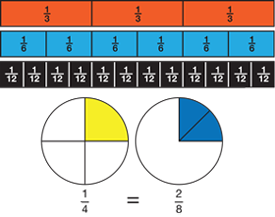Students find common denominators and use them to add, subtract, and compare fractions. They use estimation to check the reasonableness of their answers.
Content in this Lesson
- Identifying and finding equivalent fractions using fraction circle pieces, number lines, and multiplication and division strategies [E1, MPE2].
- Finding common denominators and using them to add, subtract, and compare fractions [E10, MPE2].
- Adding and subtracting fractions including those with unlike denominators using area models and paper-and-pencil methods [E8, MPE2].
- Making connections between fraction circle pieces and paper-and-pencil methods for adding, subtracting, and comparing fractions.
- Estimating sums and differences of fractions using benchmarks and mental math strategies and checking for reasonableness [E9, MPE3].
- Solving word problems involving addition and subtraction of fractions [E5, MPE1].
- Representing addition and subtraction of fractions with fraction circle pieces, number lines, and number sentences [E2].
- Explaining solution strategies [MPE5].
- Using labels to show what numbers mean [MPE6].
Assessment in this Lesson
| Assessment | Expectation Assessed | Math Practices Expectation Assessed |
|---|---|---|
|
Using Common Denominators |
|
|
|
Working with Fractions Quiz |
|
|














 and
and  since 15 is divisible by both 3 and 5.
since 15 is divisible by both 3 and 5.  and
and  .
. ,
, ,
, are equivalent to each other, and
are equivalent to each other, and  and
and  are equivalent to each other.
are equivalent to each other.
 and
and 